Latest News Blog
March 2014
Waitaki Girls High Research Visit
Monday, 31st March 2014
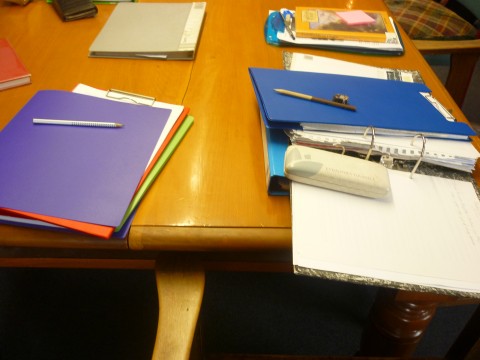
Researching in our conference room
Last Friday, Year 12 History students from Waitaki Girls High immersed themselves in the Lakes District Museum's archives finding information for their History assessments.
Students had a wide range of focusing questions from women, to the Chinese, to the impact of law and order on the goldfields. The girls also discovered different leisure activities that were popular during the late 1800's such as dances, and attending openings for bridges and other larger building structures.
One of the bonuses of this visit was that the students also had the opportunity to visit some of Arrowtown's historic sites such as the Miners' cottages and Chinese village. The visit finished with students gold panning in the Arrow river, with some lucky girls finding gold!
We hope you have lots of valuable information, please comment below about what you enjoyed from your visit to the Lakes District!
Gore High Geographers Gather Knowledge
Thursday, 27th March 2014
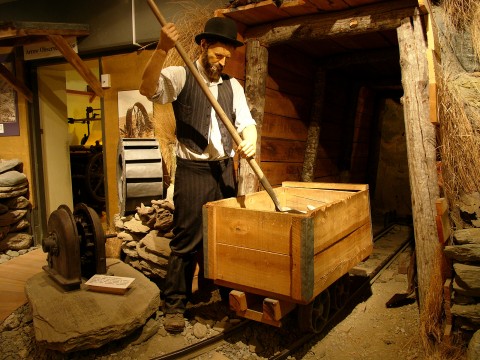
Settlers travelling to the Wakatipu region for agriculture and for the gold rush helped improve road access which lead to the beginnings of tourism
Today over 30 Gore High geography students visited the Lakes District Museum and were given an expert talk by the Director, David Clarke. Looking at the changes in Arrowtown over time and the impact of people and tourism in the area, David explained how Arrowtown is leading the way in preserving its heritage.
Students were also given a tour of the Chinese settlement where issues of racism was discussed, as well as the hardships the Chinese settlers experienced during the late 1800's. The tour of the settlement highlighted how Arrowtown uses cultural tourist sites to generate a certain ambiance in the township which encourages growing visitor numbers.
Passive (golf, walks, cycling) and adventure (jet boating, bungy jumping, sky diving) based activities in the Wakatipu were brought to the students attention, as it shows how the Queenstown region has a focus on diversification for sustainable tourism. The positive and negative effects of tourism were also discussed, with students acknowledging that an obvious negative would be the impact on the environment.
We hope you found your visit worthwhile and it would be great if you could post us a comment about what you enjoyed during your visit of Arrowtown!
Heriot Have a Blast!
Wednesday, 26th March 2014
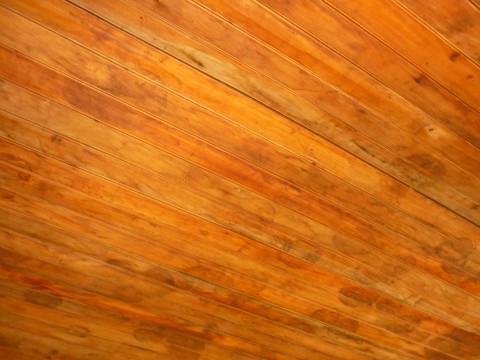
The roof of Saint Mary MacKillops school room. Can anyone remember what caused these marks?
Wendy our Educator worked with Heriot school today. The students had a chilly start to the morning, with the Autumn weather creeping in, but that was NOTHING compared to the frosty personality of Miss Gray!
Heriot school had a full day programme here at the Lakes District Museum which meant the students had a full on day with these activities:
- An 1880's school room experience with a scary teacher called Miss Gray. Miss Gray taught the students handwriting and arithmetic, and she had a cane to use on any naughty students.
- A museum visit, where students got to explore the museum as well as handle some extremely precious artefacts. Student's got to hold a moa bone, a poha, and a pounamu mere.
- A historic walk of Arrowtown showed students the wee miner's cottages that the settlers lived in over a 100 years ago. Students were also locked in the Old Gaol, and got to retrace Saint Mary MacKillop's footsteps at St Patrick's Church and the old Catholic school.
- A tour of the Chinese settlement introduced students to the difficult living conditions the Chinese settlers experienced. The basic huts in the village were made from schist rock found along the Arrow river.
- GOLD PANNING was the last activity! Students learned different panning methods and some were even lucky enough to find gold.
Were you scared of Miss Gray?
Why does the Old Gaol have funny spelling? How would you spell it?
Do you think living in the Chinese settlement would have been hard? Why?
Did you find gold?
What was your favourite artefact from the museum visit?
Answer my questions and comment about your visit to Arrowtown below!
Learning about the past: Treatment of the Chinese Settlers
Tuesday, 25th March 2014
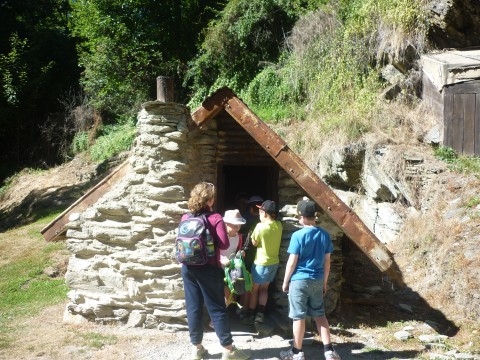
Today the Chinese settlement in Arrowtown is a popular place to explore thanks to a recent restoration project
Here in Arrowtown, a key tourist spot is our Chinese village. After gold was discovered in the Arrow river in 1862, the central Otago region experienced a gold rush, which brought a lot of settlers into the Wakatipu region. The issue with gold rushes is that people RUSH IN and then people RUSH OUT. When miners in central Otago heard about gold discoveries on the West Coast, a lot of people vacated the region to keep up the pursuit of striking it rich. This meant businesses and townships which had been established during the gold rush were now at a risk of financially collapsing as the majority relied on income from servicing the gold miners.
To solve this issue the Otago Provincial Government invited the Chinese to come to New Zealand to search for gold. A lot of the Chinese settlers were eager to make the big move to New Zealand as China was suffering from famine, and poor working conditions, and low wages. Any money found on the goldfields by the Chinese settlers could be sent back to China to help their families back home.
On arriving into New Zealand, a lot of the Chinese settlers soon discovered that even though they had been invited into New Zealand, they weren't welcome. A lot of unfounded resentment was geared towards the Chinese. A fear of economic competition was one reason why Europeans struggled to accept the Chinese settlers into their community. The European settlers also struggled with accepting Chinese culture, which was strikingly different from their own. Religion, leisure activities, traditional holidays, and smoking opium were some of the differences that the Europeans struggled to accept. This was due to a strong belief in the superiority of white people and a desire to make New Zealand a ‘Britain of the South’.
This resentment led to the Chinese settlers in Arrowtown building their township away from the Europeans, most likely to avoid racial tensions. As more Chinese settlers immigrated to New Zealand over the years, European settlers felt even more threatened. This led to the The Chinese Immigrants Act of 1881. This act was created specifically to limit the amount of Chinese settlers arriving into New Zealand. The number of Chinese who could arrive on one ship was limited to one for every 10 tons of the vessel’s weight. A poll tax of £10 was also imposed on each Chinese person entering the country. In 1888 the ratio of immigrants to ship tonnage was cut to one Chinese person per 100 tons. In 1896, it was halved to one per 200, and the poll tax increased to £100.
This shocking example of racist treatment towards the Chinese settlers, was formally acknowledged and apologised for in 2002. At a Chinese New Year celebration on the 12th February, Prime Minister Helen Clark made this statement:
"I wish to announce today that the government has decided to make a formal apology to those Chinese people who paid the poll tax and suffered other discrimination imposed by statute and to their descendants. With respect to the poll tax we recognise the considerable hardship it imposed and that the cost of it and the impact of other discriminatory immigration practices split families apart. Today we also express our sorrow and regret that such practices were once considered appropriate."
If you are interested in learning more about our Chinese Settler History check out the Te Ara website.
Do you think a formal apology by the New Zealand Government was the right move?
How else could New Zealand formally apologize and amend what has happened between the two countries?
Answer my questions and comment about this blog post below!
Darfield Does it Again!
Monday, 24th March 2014
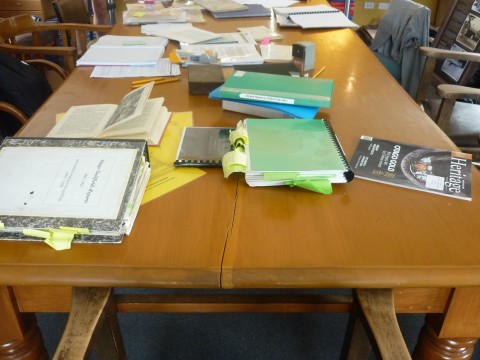
Researching in our conference room
Senior History students from Darfield High School visited the Lakes District Museum for two days for their annual History field trip!
The students researched in our conference room with access to our archives, focusing on areas such as women, Chinese settlers, and the socio-economic effects of the gold rush. A tour around the Chinese settlement introduced students to the racist attitudes the European settlers had towards the Chinese settlers. We also discussed the 1881 Poll Tax and the negative effects this had upon the Chinese settlers.
On day two students completed their extensive research, with a focus on collecting plenty of primary resources. We ended their visit with a short Historic Walk (due to inclement weather conditions)! On the walk we discussed building materials used in establishing the Arrowtown township, we also examined the Old Gaol, St Patrick's Church, and Saint Mary MacKillop's cottage.
Did you find this History trip useful?
What are some new or interesting things you learned on your visit?
Comment about your visit on the blog, and I hope you all have a safe drive home!
Columba College Collect Geographical Knowledge!
Thursday, 20th March 2014
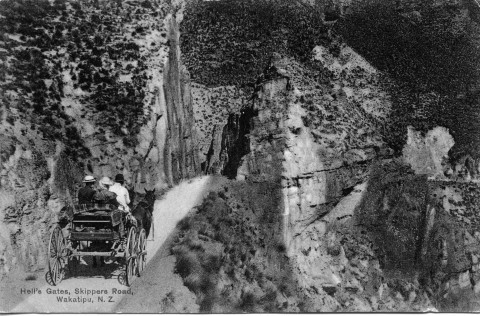
Victorian Eco Tourists Coaching into Skippers Canyon during period 1
This morning saw twenty Year 13 students from Columba College squeeze into the conference room to hear a talk on the 'tourism timeline' of Queenstown.
The talk supplemented by historic photos explained the spatial and temporal changes in Queenstown's tourism. Students completed a worksheet and a mapping exercise to illustrate these changes. Dividing progress into three periods students could also see the impact of tourists on Queenstown. As some commented tourism can be a double-edged sword, in some respects fantastic for the region - bringing in valuable $$$, but in other respects not so good - increasing visual and noise pollution....
We hope you all gained some valuable knowledge for your NCEA Level 3 Geography course (tell us about your visit on this blog!) and we wish you all the best for the rest of 2014!
St John's Ranfurly Reach Into The Past
Wednesday, 19th March 2014
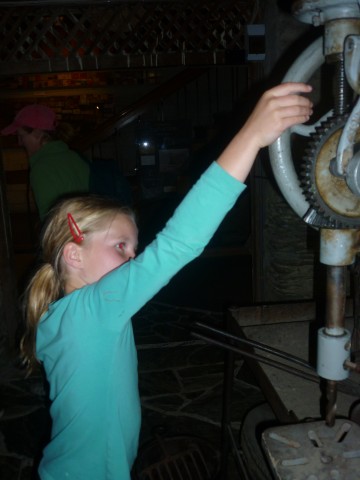
Exploring the display beside the Grog Shanty
St John's Ranfurly visited the museum today. They survived Miss Grey's classroom, explored the museum, followed in St Mary MacKillop's footsteps on a historic walk, and then visited the cemetery to learn about living conditions on the goldfields.
We hope you had a good time and learnt lots - could you survive an 1880s class?
Would you like a teacher like Miss Grey?
Why is Mary MacKillop famous?
What did you learn at the cemetery?
What was something new you learned in the museum?
Send us a message on this blog!
St Joseph's of Port Chalmers Visit Arrowtown!
Wednesday, 12th March 2014
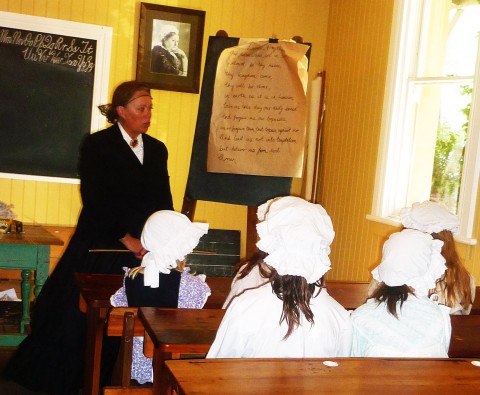
Starting class with a morning prayer
Today saw St Joseph's School visit the museum and step back in time! They experienced an 1880s classroom with Miss Grey, explored the musem, and finally panned for gold in the Arrow River! Most were successful panners and we hope you enjoyed your time with us.
What was your favourite part?
What is something new that you learnt?
Would you like to gold pan again?
Do you think learning at school 150 years ago was easy? Or do you think it was hard?
Answer my questions and tell us about your visit on this blog!!
St Theresa's See into the Past
Tuesday, 11th March 2014
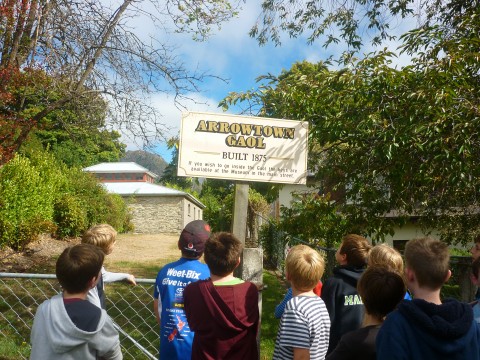
Checking out the Old Gaol
St Theresa's School from Invercargill have had their year 5 & 6 students visit for two days in a row!
These are the fun activities we got up to:
- A frightening lesson with Miss Gray in a Victorian 1880's school room - the students memorized a poem, and learnt cursive handwriting. They also learned about how much harder school life was over 100 years ago!
- Exploring the museum and learning about how the miners and the people of Arrowtown lived during the 1800's. Students got to learn more about Grog Shanty's, Long Drop's, the old Bakery, and the Phaeton carriage!
- A historic walk of Arrowtown - All of the miners cottages were so small because everyone needed to get their building materials from out of Arrowtown. Seeing Saint Mary MacKillops cottage, and skipping around Mary Cotters tree were some of the highlights of the walk.
We hope you enjoy the rest of your camp St Theresa's - you were all fantastic learners asking very insightful questions!
Why did people in the 1800's use long drops?
How did Miss Gray punish naughty students?
Why did it take Arrowtown so long to build an Old Gaol?
Can you still remember the poem you learnt with Miss Gray?
Answer my questions and comment about your visit below!
Hello Autumn!
Friday, 7th March 2014
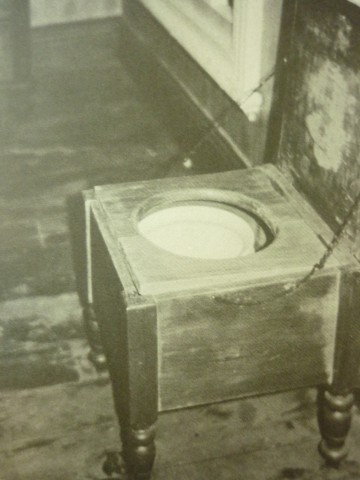
Kauri Commode
There has been a dusting of snow on the mountains, and the mornings are beginning to feel quite crisp and cool ... I think Autumn is here!
Getting out of bed on those chilly mornings can be hard work, so I wonder how our early settlers coped without electricity and proper housing to keep them toasty warm?! A lack of indoor plumbing would have made things even more difficult for people living in the Wakatipu region over 100 years ago. An outdoor toilet - or a long drop (a long hole dug into the ground) was the only option of a bathroom on the goldfields. I think getting up to go to the bathroom in the middle of the night, especially during the colder months, must have been terrible!
I think our early settlers also agreed it was terrible, as they found their own methods of avoiding stepping out into the cold in the dead of night.
A Kauri Commode could be found within settlers homes. It was a small portable vessel to be used as a toilet. This vessel would be held in a plain wooden box (probably to keep out the smell)! Sometimes these boxes could be decorated to look like small cabinets - very posh! These would often be kept in the bedroom for convenience, usually on the fathers side of the bed, as the mother would have had her baby in a cradle on her side of the bed.
For our Chinese settlers, who were invited by the Otago provincial government in 1865 to work the goldfields, they also had a solution for staying inside their huts. Chinese settlers would often break a bottom off a glass bottle and incorporate it into the walls of their stone huts whilst they were building. This meant they could go to the toilet during the night without going outside too! The Chinese settlers would place a bucket underneath the outside end of the bottle which would collect their "night dirt".
In the Arrowtown Chinese settlement, the Chinese settlers also built a long drop for the European Ladies to use when they came to visit the settlement to buy tea from the stores! This long drop is now historically protected!
What do you think about these quirky historical facts?
Do you think you're lucky to have all of our modern day conveniences?
Answer my questions and comment about this blog post below!
Principals Today Magazine Feature
Tuesday, 4th March 2014
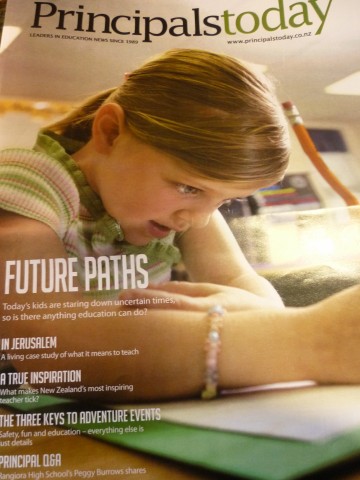
Principals Today magazine issue 101
The Hands on History Education Programme was mentioned in Principals Today magazine issue 101!
World War 100 is a huge focus for a lot of schools this year, and our timely exhibition on the effects of WWI on the Wakatipu region was an important part of our piece in Principals Today. We are also hosting another war related exhibition during 2014, which is the Shadows of Shoah, this exhibit will help students understand the grievous effects of the Holocaust.
Teachers mark these dates in your calendars because these exhibitions are going to be HUGE. Both of these exhibits will provide a momentous platform for you students to learn about peace and conflict, and the effects of war.
8th August – 13th October – Shadows of Shoah
A useful exhibition for senior history students with an area of inquiry into WWII, and for students of all ages wanting to learn about the causes and effects of WWII. After visting this exhibition, use our archives for further research! Shadows of Shoah is an artistic educational project, communicating the gravity and significance of the Holocaust in a unique way. Using photography and original music, selected episodes from survivors' experiences are presented in a brief, compelling format. To reach a generation for whom the Holocaust holds little relevance or significance, Shadows of Shoah strives to produce powerful and evocative art while carefully maintaining historical accuracy.
11th November 2014 - 25th April 2015 – The War To End All Wars
A timely exhibition for senior history students with an area of inquiry into WWI, and for students of all ages wanting to learn about the causes and effects of WWI. After visting this exhibition, use our archives for further research! This comprehensive and interactive exhibition to demonstrate the effects of WWI on the Wakatipu region using primary resources such as photographs, diaries, telegrams, oral histories, and newspapers. Our Lost War Passchendaele, a film which features Kiwi actress Robyn Malcolm, will also be on display. Our Lost War Passchendaele explores the history of Private George Salmond, who was among the 2,700 casualties of a dreadful WWI battle that few New Zealanders know of.
To learn more - read our piece in Principals Today, or contact Amy the LEOTC Education Officer via email, [email protected]
Taieri Beach School Show Off Their Acting Skills!
Monday, 3rd March 2014
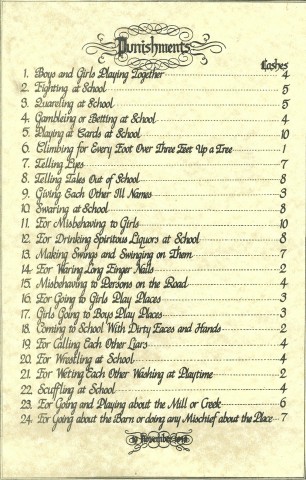
An example of the punishments students received during the 1800's
Taieri Beach School visited us on a wet, rainy, morning. It was dark and gloomy outside, but that didn't stop these students from having lots of fun INSIDE the museum.
The visit started with handling some artefacts from the Wakatipu region. Students were allowed to hold a Moa bone, a poha, a pounamu mere, and some very old mining and farming tools.
Students then explored the Museum in groups of 4. Some favourite spots were the long drop and the grog shanty!
We finished off the morning with a terrifying lesson with Victorian School Teacher Miss Gray!!! Miss Gray taught the students a poem, handwriting, arithmetic, and a physical drill. She then caned a naughty boy called Caleb! The students were fantastic actors, and it really seemed as if we had time traveled back 150 years...
What was your favourite part about visiting the Museum?
Can you remember what the word Artefact means?
What was something new you learned in the Museum?
Were you scared of Miss Gray?
Do you think learning is easier today compared to over 100 years ago?
Answer my questions and comment about your visit below!


















































